At the 2018 Tour Down Under, there honestly isn’t a ton of new bike tech. At least, bike tech within the realm that I care about. Undoubtedly there are new frames, wheels, and probably the odd brake pad. But in terms of things with electronics in them, most of that will have to wait till later this spring. January has never been a popular time for bike electronics, and that’s certainly mostly the case here this week.
Except one little thing.
Or actually, potentially a larger thing.
Spotted down here in Adelaide this week is a new power meter with Specialized branding on it – as seen above. Except, unless you were paying close attention, you might not have noticed there’s actually a few variants of this spread across two different teams. Pro team BORA-hansgrohe is running 100% of this new thingamajig, while Quick-Step is running a blend of the new thing alongside 4iiii Precision units.
But first, what happens if we simply ask Specialized about these newfound gizmos? What might they say? I asked, here’s exactly what they said:
“Specialized relies on feedback from professional athletes in developing and testing advanced pre-production products in real-world applications. Thanks to this top-level feedback some of these products, or elements of their designs, eventually show up in future retail product offerings. We call this Project Black.
So on one hand that confirms that it’s indeed a Specialized product (which was somewhat a given, since it has a Specialized logo on it). But within the pro cycling scene there are plenty of cases where mere logos are appended to things for team branding purposes. So since the above statement confirms an actual product, that confirms it’s something Specialized is cooking on.
Thus, let’s take a look at dissecting it as best as possible using the photos I shot yesterday and today at the Tour Down Under. First, we’ll start on the drive side (that’s the side with the chainrings):
What you see here is identical to that of the 4iiii Precision design for a Dura Ace 9100 crankset. 4iiii announced those units back at Interbike in September, but weren’t going to start shipping till Q1 2018…which…would be now.
For some reason I can’t find any of my pics of the R9100 with the 4iiii pod on it, but here’s the previous gen from my review last winter, as you can see, it’s identical:
Thus, so far the drive side looks the same, but let’s swing to the non-drive side (left side), and take a look at that:
Woah, now that’s an entirely different ball game there! We’ve seen nothing like that before. For reference, here’s what the 1st gen 4iiii Precision dual side looks like (below left, FC-9000), and then the planned FC-R9100 4iiii Precision dual side (from Interbike):
As you can see, both of those pods are rather plump and rounded. Compared to the Specialized pod which is much longer, flatter, and a bit thinner looking (I didn’t exactly bring fancy measurement instruments with me though). Even though 4iiii’s new R91000 pod tapers out, it’s still nowhere near the size/design of the Specialized R9100 pod.
The next thing that’s notable is a shift in how batteries appear to be accessed. With the existing 4iiii pods, you have a simple battery door that you open just using your finger. This is roughly akin to what you find on many coin cell battery compartments in other sports tech products today, including footpods and other power meters like Stages.
However, with Specialized you see it has two screws that would require a hex wrench.
Why might a company shift to this design versus the more easily opened design?
Typically one reason: Waterproofing
For example, with the existing finger-opening-accessibility of the Stages Gen1 design, they had lots of issues with water ingress. 4iiii didn’t have as many instances of that to my knowledge, but 4iiii also shipped a fraction of the units of Stages power meters. In Stages Gen2 units, they redesigned the battery door a bit which reduced water ingress issues, but still kept the finger-licking good battery door opener.
With the Specialized design though, it appears they’re going for the ‘not in our house’ approach to water. Given that the battery life of most coin cell units in this market are in the 200-300 hour range, having to use a hex wrench to access the batteries isn’t too much of a hardship.
Now, before we wrap-up, it actually gets a little bit more interesting. If you look closely at the Quick-Step and Bora bikes, you’ll see not one, not two, not three, but four variants of units onboard. They’ve got:
A) 4iiii Precision left-only (Quick-Step: Fabio Sabatini’s bike)
B) 4iiii Precision dual (Quick-Step: Michael Morkov’s bike)
C) Specialized dual variant 1 (Bora: Jay McCarthy’s bike)
D) Specialized dual variant 2 (Quick-Step: Elia Viviani’s bike)
Holy macaroni! the remainder of the team is mostly on variant ‘D’ above. Here, let me show the differences:
The first one, variant A, is interesting because that’s actually a regression from last year where they were all on dual setups to my knowledge. So not entirely sure what’s going on there. Variant B above is a clear-cut dual from 4iiii, so that’s basically a hold-over from last year. Variant C is a blend of a 4iiii-styled left-pod with a Specialized branded drive-side pod. And Variant D is Specialized on both sides.
When I was taking team bike photos, the mechanic had started to give me Variant C, and then a few seconds later glanced down and realized I had what he described as an older design, and swapped it to Variant D – the flatter one. So clearly it’s something Specialized has been testing for a while, or at least long enough to have various iterations with their pro teams.
All of which begs the question of when we might get more public details on this. After all, a Specialized power meter has been rumored since last summer and various tidbits have snuck out here and there since then – usually to be quickly retracted. At this point, it’s clear that Specialized is probably liking the free media attention they’re getting on a semi-secret looking product.
My best guess is that we’d see some sort of announcement by or at Sea Otter (mid-April). That’s usually the next stop on the cycling product train schedule, with a handful of products also announced just ahead of Sea Otter (thus March) to build a bit of momentum and awareness going into Sea Otter. Hard to know here, but no doubt whenever it’s announced I’ll be there to dig into it in far more detail than my stalker shots here in Adelaide.
With that, I’m hitting the publish button – time to get out on the bike today and…test some power meters. Thanks for reading!
FOUND THIS POST USEFUL? SUPPORT THE SITE!
Hopefully, you found this post useful. The website is really a labor of love, so please consider becoming a DC RAINMAKER Supporter. This gets you an ad-free experience, and access to our (mostly) bi-monthly behind-the-scenes video series of “Shed Talkin’”.
Support DCRainMaker - Shop on Amazon
Otherwise, perhaps consider using the below link if shopping on Amazon. As an Amazon Associate, I earn from qualifying purchases. It doesn’t cost you anything extra, but your purchases help support this website a lot. It could simply be buying toilet paper, or this pizza oven we use and love.

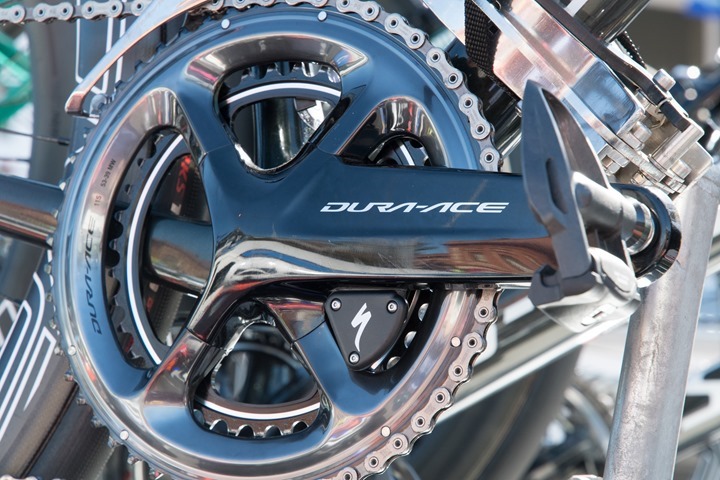
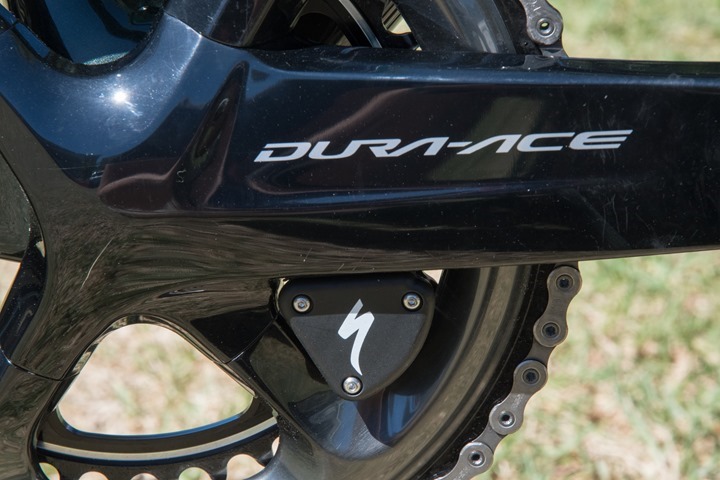
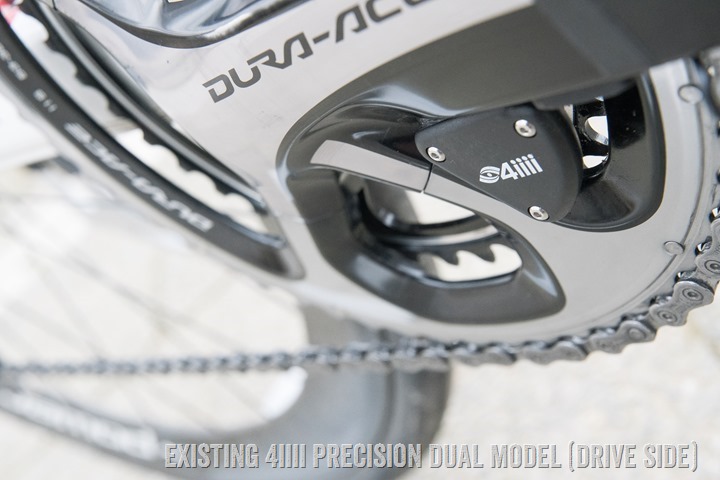
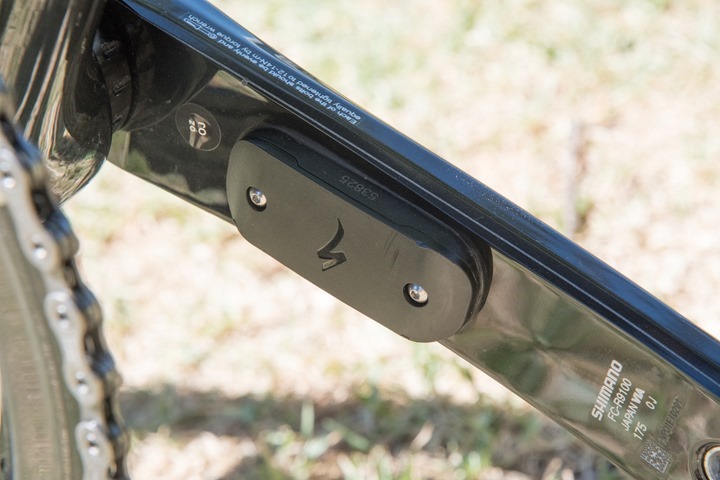


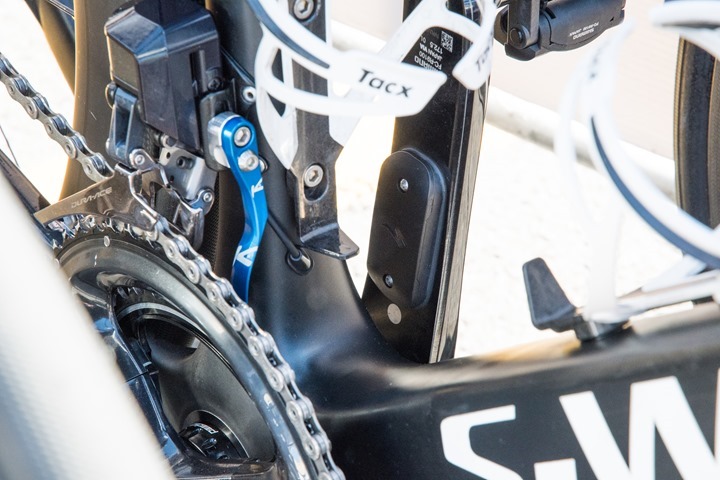
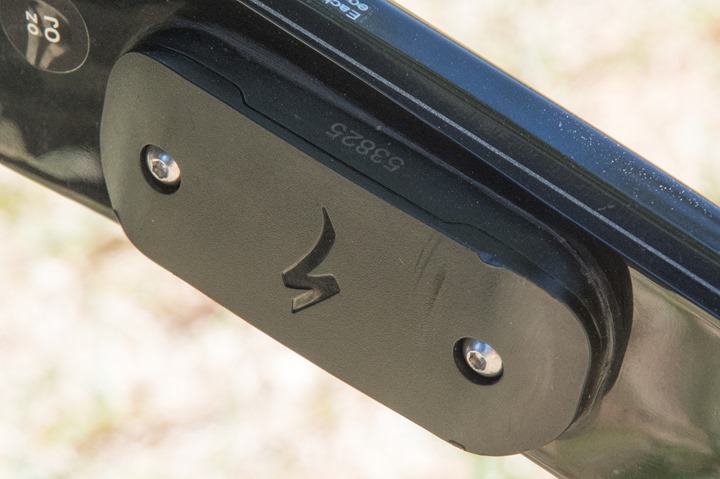
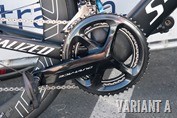
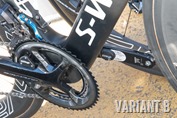
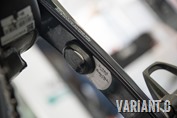
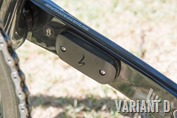





















Variant C is on a 172.5 length crank, variant D is on a 175 mm long crank. Might be that they just made one run of 175 mm cranks in the new for factor?
Obviously just a rebranded 4iiii unit. Possibly only for World Tour use, maybe 4iiii didn’t feel like they were getting a return on their sponsorship money and Specialized put up some extra cash to add their logotype instead?
While it could be released for general sale (like Cateye already sells rebranded 4iiii product) I must say that seems unlikely. If Specialized were to release their own powermeter, surely they wouldn’t be using someone else’s crankset.
“Obviously just a rebranded 4iiii unit.”
No, it’s more than that. The battery cover on the left crank is injection moulded, with a Specialized logo as part of the mould. Given the cost of making such moulds, it would likely not make sense to create a mould just for the pro teams, when screen printing the logo on would be much cheaper and perfectly good enough (as they have done on the right side).
Implication – this is close to a real product. Whether Specialized has done a deal with 4iii, or quietly acquired the company, we will find out in due course.
What makes you think it is injection moulded? I was thinking 3D printing (because of the logo) with the longer form factor and screws making it easier to swap out the internals – so not production at all. But I certainly could be wrong.
Because there are none of the striations typically seen in 3D printed parts.
Also, that variation in surface finish (glossy logo, rougher elsewhere) is not easy to achieve with 3D printed components. That’s not to say they didn’t post-process to get the finish, but I think it’s injection molded as well.
It appears that Specialized and 4iiii has had a closer relationship for quite some time now. – link to pedalmag.com
Nice observations… Now one can only imagine what’s really happening behind these scenes. I’m just wondering…. Specialized had bought other companies in the past to add to their own offering, which fits in the overall trend where large cycling brands offer bikes with only inhouse branded parts. Some Specialized example, the initial crancks come from Lightning, wheels from Roval, etc… There is no overlap in 4iiii product portfolio with Specialized. 4iiii has been pioneering towards new types of products, which Specialized also does. Could it be 4iiii will soon be part of Specialized?
“Water ingress”
I’d like to know the benefit of this power meter over the previous design of Specialized cranks with a Quarq chainring spider. Can you only get individual leg power from this dual-pod design? Do crank spider based units not do this by measuring the strain on the full 360* pedal stroke and identifying the two peaks at 180*? I wonder if this is a way to get Specialized into the market of people that buy their bikes, but would rather have a crank that matches the rest of their groupset?
The Quarq design only gets total power, whereas this 4iiii/Specialized/whatever design gets dual leg power (individual power).
My guess is any solution Specialized is working on would be an upsell on their bikes.
Just an upsell? Might Specialized use some of financial might to offer a power meter at a much better price than Shimano’s? I’d think that Specialized has the financial might to offer a PM at a price that would put pressure on a lot of PM manufacturers.
I reserve the right to be wildly wrong.
Specialized has their own cranks that comes with their high end sworks bikes:
link to specialized.com
So as a pure specialized only effort this seems strange
Um, that is what I was thinking, yet Specialized cranks are carbon, right? One would think they would double down on a fully integrated crank as a singular product in lieu of power meter add on. The market is already getting crowded with crank power meters, and Specialized is not a company to come late to the market without a significant innovation, and do not recall their ever being interested in the low end price point of the market.
Sea Otter also makes sense since it’s pretty close to the big S up in Morgan Hill.
Immediate first thought this was going to be the Shimano DA power review; got my hopes up haha ;(
Hey Ray,
Did you bring your WASP with you to capture any data as the riders fly past? Wondering if that close up of the pod on the left crank arm is an ANT+ ID?
Cheers,
Ben.
GTN found the new Specialized power meter on a pro triathlete bike, though this one had their own carbon cranks! Now this seems much more like an upcoming retail product than one using Shimano cranks:
link to facebook.com
My guess would be that the Pro Team bikes featured in this article were only for testing a new revision of the 4iiii hardware. The next generation of 4iiii’s own product may well use this form factor as well but I still don’t think they’re intended for retail release with Specialized branding intact. Unless Specialized has silent acquired 4iiii outright…?
When will you be reviewing the new Dura-ace power meter? I am going to purchase a new unit soon and its between a new Quarq, which I know works and the Dura-ace. Thank you
Yup…it’s sitting next to me.
Can anybody help with which bike computer will work with this dual sided Specialized power meter (i’m lucky enough to own one – the wife let her guard down)?
By that I mean a computer that will allow you to pick up two power meters at the same time? I currently have a Garmin 810 and I get a message of ‘multiple power meters found… try moving away and try again’ or something similar. It’ll only pair with one at time.
I’m assuming it’s the Garmin 810 that’s the limitation. I’ve been scouring the internet for hours and can’t find a lot on this topic.
Any recommendations for a better bike computer to pick up multiple PM’s? Wahoo Element?? Garmin 820?
?????
I believe there’s one more question mark you were missing. Here, I found it: ?
i know this is an old post but i have this exact model and i dont know whether the left or right power died (its not the battery) is there any way to get a replacement or do i need to spend $600usd for a whole new Durace R9100 set.
Thanks